Our final UDO series post: help Charlotte’s neighborhoods grow sustainably
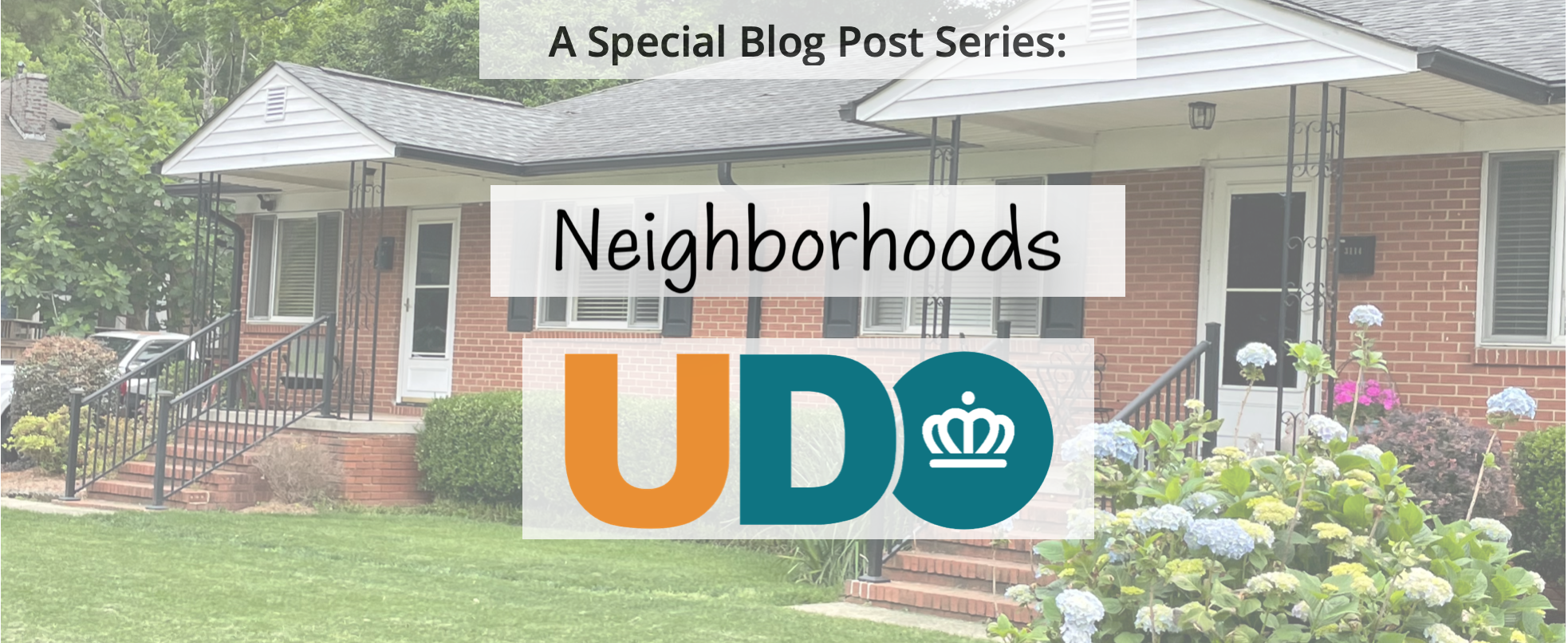
Welcome back to our UDO series!
If you’ve missed our previous blogs, no worries, we got you! To catch up, you can start with our introductory blog where we talk about what UDO is and what it has to do with the Charlotte Future 2040 Comprehensive Plan that many of you might have been involved with. Without going into too much detail, the Comprehensive Plan is a multifaceted vision of the future, like a sketch drawing by a designer meant to convey the idea of the project. In contrast, the UDO is like the blueprints used to build the project.
As a part of this UDO series, we also published a blog covering the environmental aspects of the UDO. Care about preserving floodplains and heritage trees? Go check it out! Last week, we also posted a blog that discusses how the UDO will impact transportation in our city. We are excited to see how the new ordinance will lead to more EV stations to address the growing interest in this kind of infrastructure in our city and the environmental benefits that would come with this.
As the city has extended the period of public input on the new UDO draft to March 18th from the initially set deadline in February, we are using this opportunity to educate our readers on the parts of the UDO that might be crucial for our city’s development. At the end of each blog in the series, including this one, you will find suggestions that you can use to submit to the portal. Feel free to copy and paste, or modify them in a way you seem fit.
Diversity of neighborhood types with more dense and walkable residential areas
With few exceptions, the UDO doesn’t offer a new set of neighborhoods compared to those that currently exist in the zoning ordinance. However, it refines the regulations for the existing zoning districts with a goal of supporting the future development of more walkable, compact, and mixed-use neighborhoods, as envisioned in the Comprehensive Plan. The table below provides an explanation of how existing (aka conventional) zoning districts transition into the one created in the UDO.
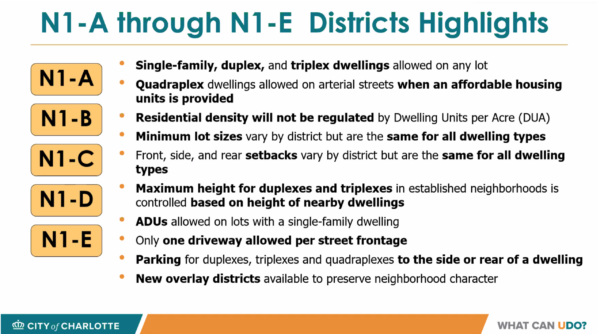
The proposed UDO zoning districts will be the residential “Neighborhood 1” and “Neighborhood 2”, “Commercial”, “Campus”, “Manufacturing & Logistics”, “Innovation Mixed-Use”, “Centers”, “TOD”, “Overlay” and “Special Purpose” districts. Most of the groups listed have their own separate subcategories as seen in the image below.
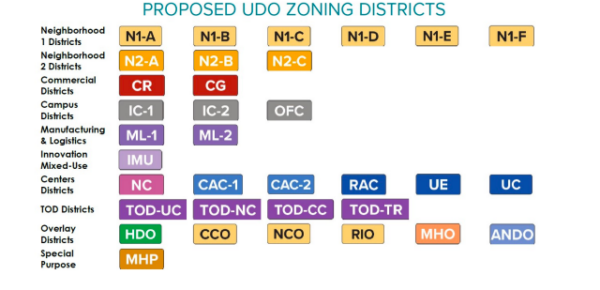
We are focusing on the residential neighborhoods, as the residential districts have spurred the biggest public interest and have been the most controversial. Zoning districts N1-A through N1-E allow for single-family, duplex, and triplex dwellings on all lots as well as quadruplex dwellings on arterial streets when an affordable housing unit is provided.
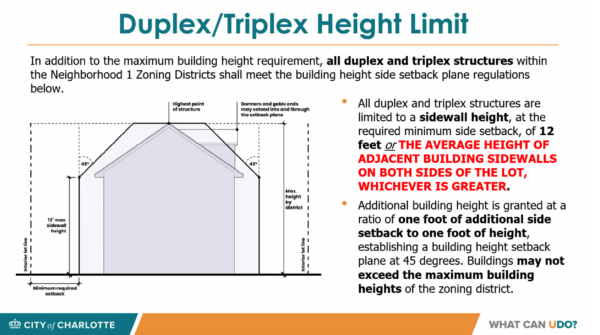
The N1-F Zoning District allows all dwelling types allowed in N1-A through N1-E Zoning Districts; as well as small-scale townhouse and multi-family dwellings. The Neighborhood 1 Zoning Districts also allow for select nonresidential uses, such as places of worship and educational facilities, and for the reuse of existing neighborhood commercial establishments under prescribed conditions. Below are the highlights of what could be developed in districts N1-A to N1-E.
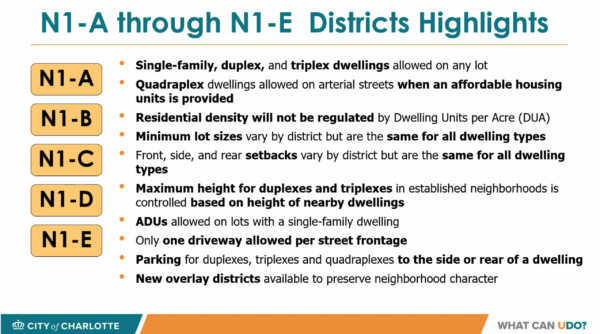
“Neighborhood 2” or “N2” is another group of residential districts. The difference lies in the types of development that would be allowed. For example, there is no maximum density for developments built for residential uses in these districts. While some sub-categories of N2 would allow less densely developed structures to be built (good old single-family housing), the primary purpose of this N2 neighborhood type is to accommodate the needs for multi-family and townhouse dwellings.
Just as in N1 neighborhoods districts discussed above, N2 would allow a number of non-residential uses, such as educational facilities and some types of commercial establishments.
Why is it important?
Charlotte needs to move beyond the car-centered and racially segregated patterns that were allowed to expand by the destructive policies of the past. To move towards a new more walkable, inclusive, and sustainable city that we all deserve, we need to embrace a new way of thinking about how we organize the space we live in.
Neighborhood zoning districts (N1, N2) are the predominant land use in our city. Having denser and more compact residential structures together with other tools of the UDO would allow for more coordinated land use. This will also help maximize investments in rapid transit, bike lanes, and sidewalks while providing a higher quality of life at an affordable price.
Development Bonus and other community benefits
To address the growing need in our city for affordable housing, the UDO will incorporate development bonuses. Article 4 discusses the development terms in N1 types of neighborhoods, also includes the terms under which the developer could use a voluntary mixed-income bonus. Under these terms, developers would be able to increase the number of lots for development but would have to make sure that some portion of the units constructed on those additional lots is given out for families with households income below the AMI. This bonus is not tied to any particular geographic area.
Another set of development bonuses is discussed in Article 16. The purpose of this bonus is to provide benefits to the developers by allowing them to build structures at increased heights in exchange for the improvement of local infrastructure, provision of affordable units, enhanced street connectivity, to name a few.
Why is it important?
By encouraging the developers with bonuses, the new plan would help build a more affordable city. The city has a good example of bonus use in the Transit-Oriented Development districts: “A total of five projects have used the affordable-housing bonus. To date, the city has received commitments for 33 units and $709,000 in fee in lieu payments to the Housing Trust Fund.”
How I can help?
As we mentioned earlier, the city has created an opportunity for the public to voice their concerns and suggestions about the current UDO draft by submitting their comments through the UDO portal. To make it easier for you, we have prepared some comment templates of what could be submitted. Feel free to just copy and paste them into the portal, edit them in a way you deem fit, or submit your own.
The detailed instructions on how to submit your comments to the portal are listed at the end of our previous blog.
With the deadline for the feedback on the first draft of the UDO is approaching this week, and with this blog being the last one in our UDO series, we decided to list below templates of comments that you might choose to submit to the UDO portal including comments from the Environmental and Transportation blogs.
Please use the article number and title before putting your comment into the portal, so staff can associate it with the proper section.
Residential Neighborhood N1 and N2
Article 4. NEIGHBORHOOD 1 ZONING DISTRICTS; Article 5. NEIGHBORHOOD 2 ZONING DISTRICTS
Suggested wording:
- The voluntary mixed-income residential development bonus that applied to developments in N1 districts should also apply to structures in N2 districts;
- The allowed additional footage for height in N2 (A and B), either through the use of bonuses or additional setbacks;
- The UDO should incorporate more incentives for developers to build affordable housing in our city;
- It’s important that the UDO supports higher residential density throughout various residential districts to allow for duplex, triplexes, and quadruplexes (in N1) and townhouses and multi-family units (in N2 and higher).
Trees
Article 29: Tree Protection – Section 3: MAINTENANCE and PROTECTION OF TREES
Suggested wording:
- Please preserve higher rates of fees for removing trees, particularly heritage trees;
- It is important we preserve and increase the tree canopy. Trees provide wildlife habitat, shade our neighborhoods/energy savings, improve air quality, and make our community more resilient to the impacts of climate change;
- As tree canopy in the city is decreasing, we need a UDO that helps the city reverse that loss;
- The city through the UDO should provide more incentives to protect trees and support the planting of new ones;
Floodplains
Article 27. FLOODPLAIN REGULATIONS
Suggested wording:
- Development should not be allowed to happen within floodplains (as defined by the 15-foot distance from the top of the creek/stream/pond bed), as it is neither safe nor environmentally sound;
- Keeping development away from floodplains will improve surface water quality and minimize damage to infrastructure and property;
- Floodplains, while not suitable for building upon, could be turned into infrastructure that the community could benefit from such as greenways;
- As the population of Charlotte is projected to be growing over the next several decades, it is important to plan responsibly for that growth by not building in flood risk areas. Development in those areas will cost residents and the city more in long run;
- Any fees collected from tree removal should be directed to fund tree loss mitigation measures (for example, planting of new trees, educational events, etc);
Parking
Article 19: Off-Street Vehicle & Bicycle Parking – Section 3: Table 19-1 Vehicle Parking Requirements
Suggested wording:
- Some zoning districts that are designed to be developed as more walkable pedestrians friendly spaces, such as TOD, should have lower parking maximums;
- Add the option for nongovernmental ownership if there is a shared parking agreement in place;
- Remove limits on the bicycle parking (19.4 REQUIRED BICYCLE PARKING Part C);
- Consider changing how the UDO Calculates the number of spaces using something other than GFA; we suggest using Net Internal Area (NIA): The net internal area is the usable area available to occupants of the building. It’s calculated by taking the gross internal area and subtracting floor areas being used by: lobbies/storage/service areas, machinery rooms on the roof, stairs/escalators/elevators, building columns, and risers. Simply updating the GFA definition to include the above exclusions will also work.
EV Charging stations:
Article 19: Off-Street Vehicle & Bicycle Parking – Section 3 Required Electric Vehicle Charging Stations
Suggested wording:
- The city should implement more EV charging stations in the city to curb the amount of GHGs in the air we breath;
- The EV requirement should apply to all sizes of parking spaces, including parking lots with only 0-9 and 10-25 parking spaces. A clear statement of office use is needed to Part C’s requirement of EV charging stations;
- The UDO should enhance the existing EV infrastructure because, in order for people to switch to electric vehicles, people need to make sure that there are charging stations available for them, the same way as gas pumps are available for the majority of cars users;
- The city has committed to adopting more electric vehicles for city use in order to reduce emissions. Those efforts are not enough, and the private sector and residents should join the efforts;
Comprehensive Transportation Review
Suggested wording:
- Some suggested programmatic strategies have a questionable distribution of points. For example, the distribution of materials should be 0.5 points instead of 1;
- Some strategies do not provide mechanisms for how their efficiency would be assessed over time, and whether points should be reevaluated;
- Strategies should be implemented to evaluate the efficiency of the mitigation measures;
- More car sharing spaces should be dedicated for shared ride/car share parking, with a focus on hourly/daily car rentals vs on-demand types;
- We want to make sure that the changes are going in a wider geography, so the impacted residents are not left behind;
- More mitigation strategies to add: “bus stop improvements” (for example, 1 point for the provision of a bench, and 2 points for provision of a shelter”; additional measures that would offset the need of travel, especially in a mix-use development (provision of the fitness center; convenience/grocery store; parcel drop off on-site for shipment”); car-share subsidy for membership costs).
Thanks for reading!
As a nonprofit, community support is essential for us to keep doing what we do — including providing free articles like this. If you found this article helpful, please consider supporting Sustain Charlotte.
Want to stay in the loop? Subscribe to our weekly newsletter and follow us on Instagram, Facebook, and Twitter.
